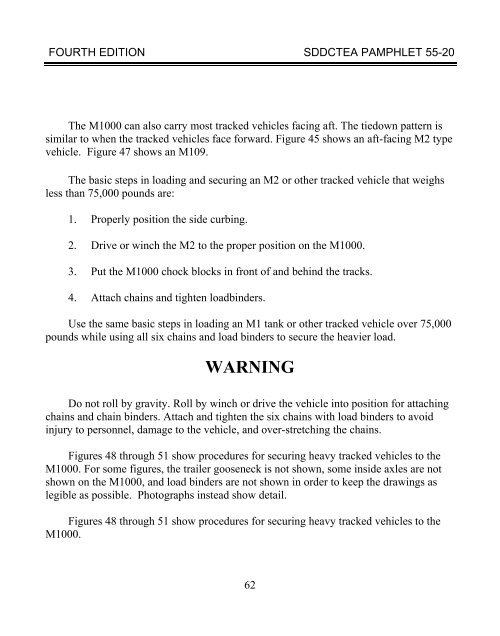TEA PAM 55-20 Tiedown Handbook for Truck - Military Surface ...
TEA PAM 55-20 Tiedown Handbook for Truck - Military Surface ...
TEA PAM 55-20 Tiedown Handbook for Truck - Military Surface ...
Create successful ePaper yourself
Turn your PDF publications into a flip-book with our unique Google optimized e-Paper software.
FOURTH EDITION SDDC<strong>TEA</strong> <strong>PAM</strong>PHLET <strong>55</strong>-<strong>20</strong><br />
The M1000 can also carry most tracked vehicles facing aft. The tiedown pattern is<br />
similar to when the tracked vehicles face <strong>for</strong>ward. Figure 45 shows an aft-facing M2 type<br />
vehicle. Figure 47 shows an M109.<br />
The basic steps in loading and securing an M2 or other tracked vehicle that weighs<br />
less than 75,000 pounds are:<br />
1. Properly position the side curbing.<br />
2. Drive or winch the M2 to the proper position on the M1000.<br />
3. Put the M1000 chock blocks in front of and behind the tracks.<br />
4. Attach chains and tighten loadbinders.<br />
Use the same basic steps in loading an M1 tank or other tracked vehicle over 75,000<br />
pounds while using all six chains and load binders to secure the heavier load.<br />
WARNING<br />
Do not roll by gravity. Roll by winch or drive the vehicle into position <strong>for</strong> attaching<br />
chains and chain binders. Attach and tighten the six chains with load binders to avoid<br />
injury to personnel, damage to the vehicle, and over-stretching the chains.<br />
Figures 48 through 51 show procedures <strong>for</strong> securing heavy tracked vehicles to the<br />
M1000. For some figures, the trailer gooseneck is not shown, some inside axles are not<br />
shown on the M1000, and load binders are not shown in order to keep the drawings as<br />
legible as possible. Photographs instead show detail.<br />
Figures 48 through 51 show procedures <strong>for</strong> securing heavy tracked vehicles to the<br />
M1000.<br />
62





